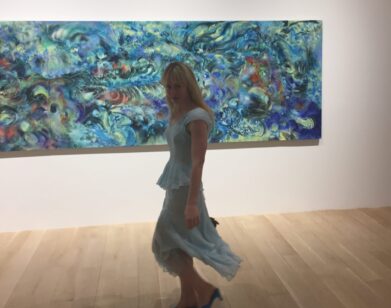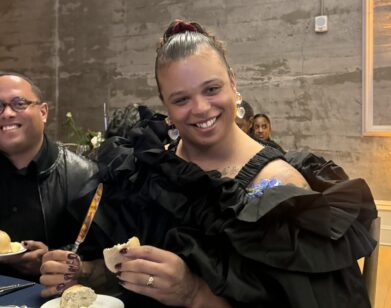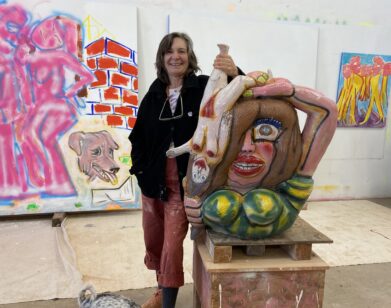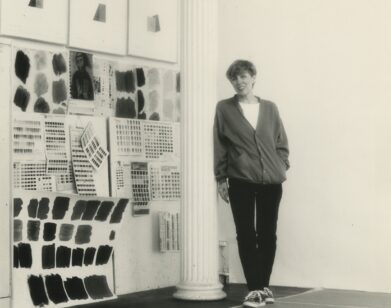Kasia Fudakowski: Sculpture With Ears
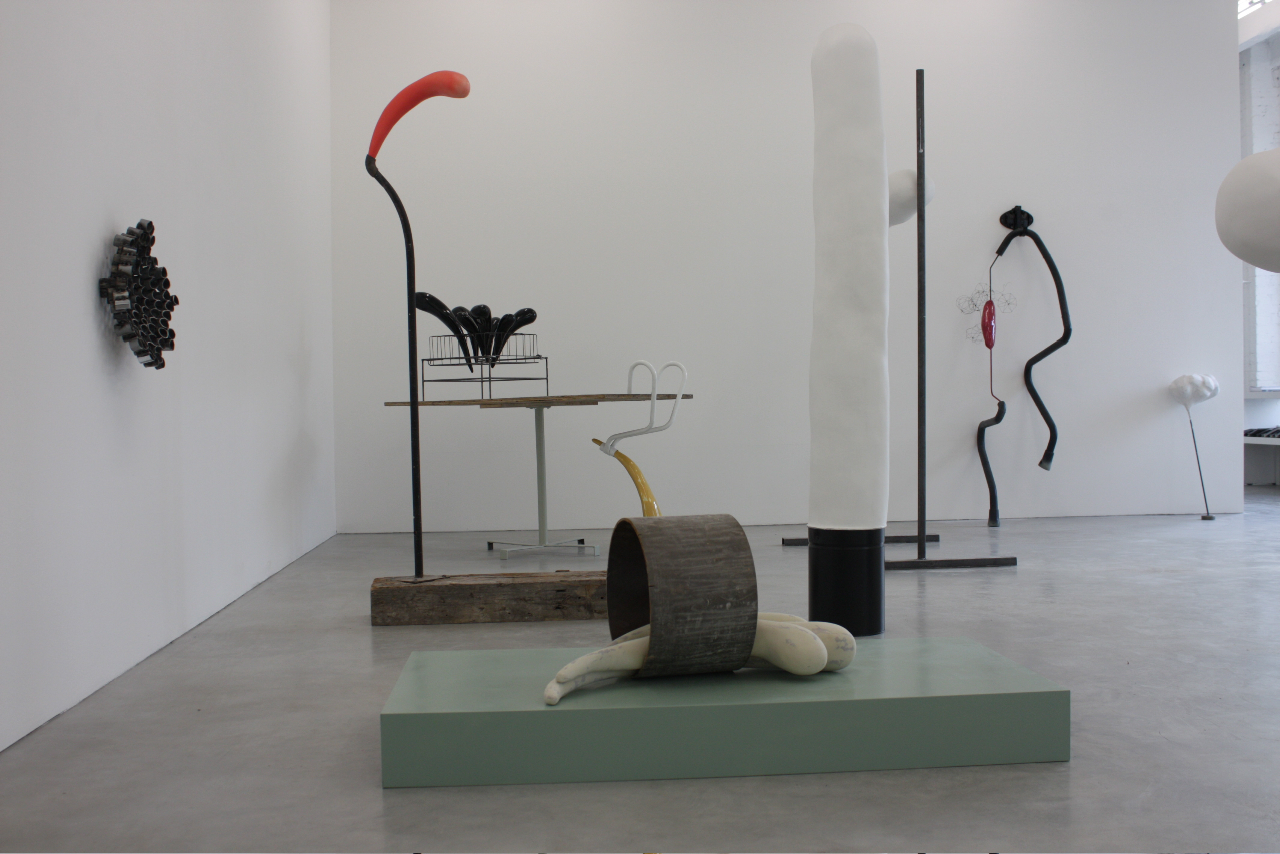
When I first asked sculptor Kasia Fudakowski for an interview, she took me aside, “Do you want to do the deed with the work as witnesses, or more discreetly in a coffee shop?” Indeed, her irregular, animated works loom so vividly they look like they might be deft enough for a Q&A of their own. Fudakowski makes odd forms emerge from everyday objects: Tables, buckets, and walls are infused with a personality that Pixar would esteem. Clean coats of lambent reds, yellows, and blacks seal off shapes made of plaster, wood, and stringent foam—forms that appear frozen, mid-ooze, along the floor, or in half-spurt above the viewers’ heads. But Fudakowski’s sculptures are more than simple, abstract gestures; they’re actual characters that hint at an absurdist narrative and delineate cohesion where there would otherwise be meaningless clutter. These characters include, among others, harvested white asparagus, a reclined transvestite, a lonely fisherman, and a glum horse on its way to the knacker’s yard. (LEFT: OPENING AT ZAK BRANICKA. PHOTO BY MATTHEW EVANS)
Interview sat down with Fudakowski (with the work as witnesses) on the occasion of her first solo show at Krakow/Berlin-based gallery Zak Branicka, “Gleaning the Gloss.” She discussed Polish doughnuts and 1960s British comedy.
MATTHEW EVANS: Kasia, you’re half Polish, half British?
KASIA FUDAKOWSKI: Yes, but I grew up in England, and I spent one year and almost every holiday in Poland.
Photos courtesy Zak Branicka Gallery.
ME: How long have you been in Berlin?
KF: Two and a half years.
ME: Why Berlin?
KF: Because you can flounder around and still have a home.
ME: There is a certain amount of sustainability here even for people who are floundering. Do you go back to Poland often?
KF: Yeah, I’ve become re-patriated.
ME: Is there a big Polish contingency in England. Where did you grow up?
KF: Yeah, in the suburbs of London there’s a big Polish contingency. I had Polish school every Saturday with the bastions of the Polish community. They weren’t really teachers, just old women.
ME: Are Polish doughnuts really popular in London? In the Polish neighborhood in New York, Greenpoint, doughnuts are a big craze.
KF: Uh, yeah. But I’ve learned more about Polish doughnuts from American radio than in Poland.
ME: A lot of your work negotiates between the abstract and the figurative. And so many people are dropping references for this show—everything from Louise Bourgeois to Philip Guston. Where are you coming from in terms of influences?
KF: Well I made terrible work in art school. I just spent a lot of time agreeing with people. The work I’ve made since has been in a sense a release from that. I always feel like it’s not my role to talk about my influences; that’s for art critics and historians to do as they see fit—I’m just swimming in it. Obviously I’ve loved, and hated Louise Bourgeois, and now that’s all in the work.
ME: But do you have anyone you admire, who influences your work directly?
KF: There’s Franz West. And Fischli and Weiss are the pinnacle for me. They don’t influence so much what I make but more how I want to go about it. The scale of human emotions presented from the flippant, transient, borderline meaninglessness to the deep and clawing.
ME: But they also worked in film and furniture. Have you ever thought about working with film or furniture?
KF: hmmmm. I feel really strongly [that I am] a sculptor.
ME: What about the title of the show, “Gleaning the Gloss”? You don’t typically glean gloss. You buy gloss.
KF: It’s actually a reference to a comedy show. I love comedy from the 60s, like “Beyond the Fringe.” That’s what I listen to in my studio: comedy. I find it relaxing. In another life, I can imagine standing before a crowd and making them laugh and going mad, really crazed from the power. “Gleaning the Gloss” is a quote from an Armstrong and Miller podcast. Gleaning, in the context of the recording, is about reading a lot of magazines, and thereby gleaning the information from the gloss. And I also like the action of it, the agricultural association.
ME: There are a lot of agricultural elements in your work.
KF: It’s something that just came to me afterwards, that it all takes place outside.
ME: But then you have these urban characters, like the transvestite.
KF: But it’s all outside.
ME: The forms and shapes themselves are all rough, whereas the surfaces are quite clean.
KF: Well, there’s always a raw/clean thing going on; I think that’s a very basic technique. You make the gloss even glossier because you’re putting it with something rough. But what I find interesting about making something glossy is that you have to work for a huge amount of time with the object to get it to shine.
ME: So the gloss is also about process and time working in reverse, and not just what we think of as something glossy, like a commodity?
KF: It’s like seeing a stone step in a centuries-old church that’s grown shiny over the years from wear and use.
ME: What about the preoccupation with displaced characters—the transvestite, or the knackered horse? All of them are more or less culturally left behind, waiting to be gleaned.
KF: I’ve never seen it that way. I’ve seen it more that these characters are quite preoccupied with what they are, confident, self absorbed. But also, it’s been a shock for me putting the stuff in a gallery; everything became much more minimal here. I think especially with this work, because it’s sort of standing in half-storage.
ME: A little awkward, a little shameful. But you also present these obstacles, which seem to interact with the viewer. Some of them look like hurdles or have an athletic quality to them.
KF: Interactive in the sense that they’re supposed to block the flow of movement throughout the gallery?
ME: But also in the sense that you can actually move them; they continually redefine the space for the viewer.
KF: While I was making the rest of the work, it all felt very small, and European. And these little narratives—you have to give them enough space and time to evolve. I wanted something bigger for them to work against.
ME: More like snags in an obstacle course, or like gym class after math class.
KF: I don’t think of them that way. They’re supposed to be these pauses that don’t deal with the surface, the gloss, or the tricksy nature of the other pieces. They’re just like these kind of calm sausages. You don’t have to “understand” them.
ME: [pointing to the piece Der Angler (The Fisherman)] Are those chips that the fish are going for? Like the fisherman gets fish and chips?
KF: Those chips stand for the whittling away of time. But also, there are these great aphrodisiacs that you can buy to spray your bait with.
ME: So you can sexually attract fish?
KF: Yes, and they’re all jumping out of the water in completely immoral ways. You can spray the water as well, all around you.
ME: Sex figures prominently in your work. The forms resemble, on a very simple level, those that our culture associates with sex: dripping, exploding, etc.
KF: Well, the recurring form of the drip started as a curve. In all my previous shows, there was always this very wide curve present, and in this show it turned into this sort of drip. And it’s unavoidable to associate sex with these kinds of secretions.
ME: But it’s a deliberately simplified interpretation?
KF: Yeah, just like when anyone sees the obstacles they immediately start talking about phalluses… It’s not a phallus.
ME: Do you think it’s funny that everyone comes in and starts saying, “Ooh, it’s so sexual in here”?
KF: People are welcome to do a bit of giggling, which is probably the mood I’m looking for.
ME: But it’s very far from pornography.
KF: Just a bit of titillation. I just like making middle-aged women smile a little bit.
ME: And maybe feel a little bit perverse at the same time.
KF: Yeah, but it’s all healthy
“Gleaning the Gloss” will be on view at Zac Branicka, Berlin, until April 25, 2009.

